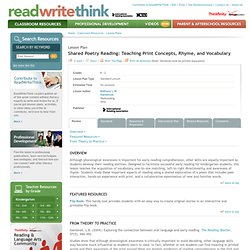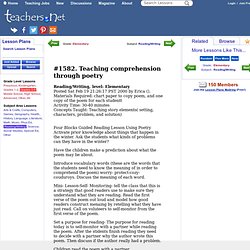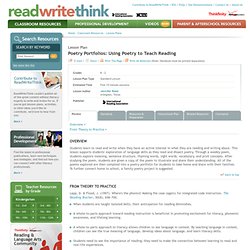

Songs & Poems - Books and Reading. Funny poetry for children. Reading Fun: Poetry. Songs & Poems - Fingerprints & Handprints. Teaching%20Phonics%20Through%20Poetry. Poetry - The Reading Lady. Poetry in the Classroom I use poetry journals in my classroom, which are small three ring binders.

You can easily substitute these with folders that have three holes in them. Just insert brads into the holes and punch holes in all poetry for insertion. When I introduce a new poem, generally I read it aloud the first day. I like to copy the poems onto chart paper for all to see. For guided reading, I would preview the vocabulary in the poem and introduce words they might have difficulty decoding. Open a Poetry Cafe to Celebrate Student Writing!
TEACHERS' MENTOR - using poetry to teach reading. Childrens Book Author Margie Palatini. Shared Poetry Reading: Teaching Print Concepts, Rhyme, and Vocabulary. ReadWriteThink couldn't publish all of this great content without literacy experts to write and review for us.

If you've got lessons plans, activities, or other ideas you'd like to contribute, we'd love to hear from you. More Find the latest in professional publications, learn new techniques and strategies, and find out how you can connect with other literacy professionals. More Teacher Resources by Grade Your students can save their work with Student Interactives. More Home › Classroom Resources › Lesson Plans Lesson Plan Overview Featured Resources From Theory to Practice Although phonological awareness is important for early reading comprehension, other skills are equally important as students develop their reading abilities.
Back to top Flip Book: This handy tool provides students with an easy way to create original stories in an interactive and printable flip book. Gambrell, L.B. (2004). Teaching comprehension through poetry (Elementary, Reading/Writing) ).

Materials Required: chart paper to copy poem, and one copy of the poem for each studentt Concepts Taught: Teaching story elements( setting, characters, problem, and solution) Four Blocks Guided Reading Lesson Using PoetryActivate prior knowledge about things that happen in the winter. Ask the students what kinds of problems can they have in the winter? Have the children make a prediction about what the poem may be about.Introduce vocabulary words (these are the words that the students need to know the meaning of in order to comprehend the poem) worry- protect-cozy- couduroys. Discuss the meaning of each word.Mini- Lesson-Self- Monitoring- tell the class that this is a strategy that good readers use to make sure they understand what they are reading. Poetry Teachers. Nursery Rhymes: Not Just for Babies! Elementary Poetry.
Reading Fluency Strategies. Home › Reading › Poetry for Fluency and Comprehension Teachable Poetry for Fluency and Comprehension covers the developing literacy needs of students in just 20 minutes, two times per week.

The purpose of fluency is to help a reader process language for both enjoyment and meaning. According to the National Institute of Child Health and Human Development, fluency and phonics are two of the main ingredients in becoming a reader. Teachers are always looking for fun and accessible texts for students to do repeated oral readings with and also model fluent reading. Within that framework is the need to model prosody and attention to the way the mechanics of language influence meaning. Teachable Poetry for Fluency and Comprehension is perfect for fluency lessons. Reading instruction strategies in each area are essential for students. 37% of fourth graders have "below basic" reading comprehension scores on the National Assessment of Educational Progress.
Order the ebooks when you need them. Poetry Portfolios: Using Poetry to Teach Reading. ReadWriteThink couldn't publish all of this great content without literacy experts to write and review for us.

If you've got lessons plans, activities, or other ideas you'd like to contribute, we'd love to hear from you. More Find the latest in professional publications, learn new techniques and strategies, and find out how you can connect with other literacy professionals. More Teacher Resources by Grade Your students can save their work with Student Interactives. More Home › Classroom Resources › Lesson Plans Lesson Plan Overview. TEACHERS' MENTOR - using poetry to teach reading. A Good Poem Will Give You Goose Bumps! Enjoying Poems by Kenn Nesbitt In the Wire Side Chat, Peeing in the Ool and Other Kids' Poems, Education World talks to popular poet Kenn Nesbitt about reading and writing children's poetry.

In that interview, Nesbitt explains why poetry is important for children and how teachers and parents can inspire a love of poetry in kids. His ideas were so helpful -- and so inspiring -- that we decided to remove them from the interview and share them in their entirety with you. Read on to discover, in Kenn Nesbitt's own words, how you can engage kids with poetry. When I visit schools, I talk to kids about poetry and I get them laughing and having fun. My methods are subversive, though. Instead, I crack them up with a poem about underwear or bugs or eating spinach (or eating bugs!) So even though I never tell kids that poetry is important, I do believe it, and here's why. Good poetry always makes you FEEL something. Dear Mr. Poetry has power.
The orators of ancient Greece honed their craft. Poetry Books.